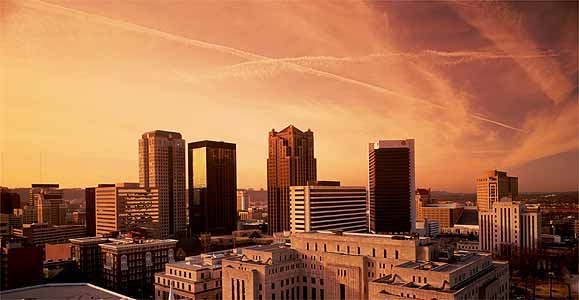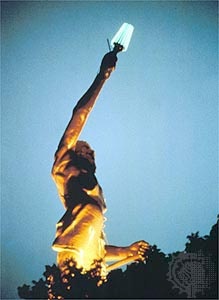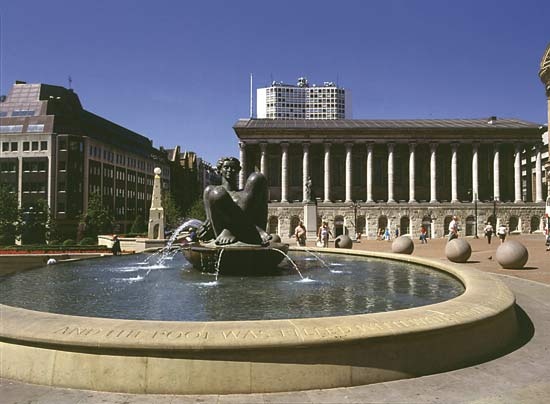Birmingham
Alabama, United States
 largest city in Alabama, U.S., located in the north-central part of the state. It is a leading industrial centre of the South. Birmingham is the seat (1873) of Jefferson county, a port of entry in the Mobile customs district, and the focus of a large metropolitan area that includes the surrounding counties of Blount, St. Clair, and Shelby as well as such cities as Bessemer, Homewood, and Fairfield.
largest city in Alabama, U.S., located in the north-central part of the state. It is a leading industrial centre of the South. Birmingham is the seat (1873) of Jefferson county, a port of entry in the Mobile customs district, and the focus of a large metropolitan area that includes the surrounding counties of Blount, St. Clair, and Shelby as well as such cities as Bessemer, Homewood, and Fairfield.The site, in the narrow Jones Valley at the southern end of the Appalachian Mountain (Appalachian Mountains) system, was settled about 1813, and Elyton (now part of Birmingham) became the county seat in 1821. In 1870 the east-west and north-south railroads met at this point; the city was founded there the following year by a land company backed by railroad officials. Named for Birmingham, England, it developed as the iron and steel centre of the South. The city's industrialization was based primarily on abundant local deposits of coal, limestone, and iron ore, essential for making steel. Dolomite, marble, barites, bauxite, pyrite, quartz, millstone, clays, sand, and gravel were also found in the area. Birmingham's most important products are iron, steel, and related manufactures (including cast-iron pipe and wrought-iron furniture). The city's industrial trend is toward diversification, and other products include aircraft parts, fire extinguishers, chemicals, paint, electronics, furniture, paper products, automotive parts, plastics, and textiles. Coal mining and high-technology industries also contribute to the economy. Education, government, banking, and health care are the chief service industries. From nearby Port Birmingham an inland waterway leads southward to the seaport of Mobile on the Gulf of Mexico.
The city is the seat of several institutions of higher education, the largest of which, the University of Alabama (Alabama, University of) at Birmingham, is a unit (founded 1969) of the state university system. Birmingham-Southern College (Methodist) was created in 1918 by the consolidation of Birmingham College (1898) and Southern University, established at Greensboro in 1856. Samford University (Baptist; chartered in 1841 at Marion) moved to Birmingham in 1887, where it was operated as Howard College until 1965. Miles College, maintained by the Methodist Episcopal church, was founded in 1905. Birmingham is also home to the Birmingham School of Law (1915) and Southeastern Bible College (1935) as well as several community colleges. The city's medical centre includes the medical and dental colleges of the University of Alabama and a number of specialized hospitals and clinics. The Southern Research Institute, founded in Birmingham in 1941, now has facilities in several other southern states.
 The Birmingham Museum of Art houses the Samuel H. Kress Collection (Renaissance art). Other attractions include the Birmingham Civil Rights Institute, Sloss Furnaces National Historic Landmark, Barber Vintage Motorsports Museum, the Southern Museum of Flight, and the Alabama Jazz Hall of Fame. The city has an opera company, a symphony orchestra, and theatre and ballet groups. Annual events include the Festival of Arts in the spring and the Alabama State Fair in the fall. Arlington Antebellum Home and Gardens (c. 1845–50) is a restored antebellum home that was used as the headquarters of the Union general James H. Wilson toward the end of the American Civil War. A cast-iron statue of Vulcan, the Roman god of fire, stands 55 feet (17 metres) tall atop a 124-foot (38-metre) pedestal on Red Mountain overlooking the city. Two state parks, Oak Mountain and Rickwood Caverns, are nearby.
The Birmingham Museum of Art houses the Samuel H. Kress Collection (Renaissance art). Other attractions include the Birmingham Civil Rights Institute, Sloss Furnaces National Historic Landmark, Barber Vintage Motorsports Museum, the Southern Museum of Flight, and the Alabama Jazz Hall of Fame. The city has an opera company, a symphony orchestra, and theatre and ballet groups. Annual events include the Festival of Arts in the spring and the Alabama State Fair in the fall. Arlington Antebellum Home and Gardens (c. 1845–50) is a restored antebellum home that was used as the headquarters of the Union general James H. Wilson toward the end of the American Civil War. A cast-iron statue of Vulcan, the Roman god of fire, stands 55 feet (17 metres) tall atop a 124-foot (38-metre) pedestal on Red Mountain overlooking the city. Two state parks, Oak Mountain and Rickwood Caverns, are nearby. During the 1960s Birmingham was the scene of violence over racial segregation as well as civil-rights demonstrations and voter-registration drives led by the Reverend Martin Luther King, Jr. (King, Martin Luther, Jr.), and others. A change in the form of city government (replacement of the commission form of government by a mayor-council form in 1963) helped improve race relations in the civil-rights struggle. In 1979 Richard Arrington, Jr., became the city's first African American mayor. In 1971 Birmingham became the first American city in which industrial plants were closed under federal law during an air-pollution crisis. Inc. 1871. Pop. (2000) city, 242,820; Birmingham-Hoover, 1,052,238; (2006 est.) city, 229,424; (2007 est.) Birmingham-Hoover, 1,108,210.
During the 1960s Birmingham was the scene of violence over racial segregation as well as civil-rights demonstrations and voter-registration drives led by the Reverend Martin Luther King, Jr. (King, Martin Luther, Jr.), and others. A change in the form of city government (replacement of the commission form of government by a mayor-council form in 1963) helped improve race relations in the civil-rights struggle. In 1979 Richard Arrington, Jr., became the city's first African American mayor. In 1971 Birmingham became the first American city in which industrial plants were closed under federal law during an air-pollution crisis. Inc. 1871. Pop. (2000) city, 242,820; Birmingham-Hoover, 1,052,238; (2006 est.) city, 229,424; (2007 est.) Birmingham-Hoover, 1,108,210.England, United Kingdom
 second largest city of the United Kingdom and a metropolitan borough in the West Midlands metropolitan county. It lies near the geographic centre of England, at the crossing points of the national railway and motorway systems. Birmingham is the largest city of the West Midlands conurbation—one of England's principal industrial and commercial areas—for which it acts as an administrative, recreational, and cultural centre. The city lies approximately 110 miles (177 km) northwest of London.
second largest city of the United Kingdom and a metropolitan borough in the West Midlands metropolitan county. It lies near the geographic centre of England, at the crossing points of the national railway and motorway systems. Birmingham is the largest city of the West Midlands conurbation—one of England's principal industrial and commercial areas—for which it acts as an administrative, recreational, and cultural centre. The city lies approximately 110 miles (177 km) northwest of London. The historic core of Birmingham, along with Edgbaston and northern neighbourhoods such as Sutton Coldfield, Erdington, and Sheldon, lies in the historic county of Warwickshire. Northwestern neighbourhoods, such as Handsworth and Kingstanding, and Harborne in the southwest lie in the historic county of Staffordshire. Southern and eastern neighbourhoods—such as Bartley Green, Northfield, Moseley, and Yardley—belong to the historic county of Worcestershire.
The historic core of Birmingham, along with Edgbaston and northern neighbourhoods such as Sutton Coldfield, Erdington, and Sheldon, lies in the historic county of Warwickshire. Northwestern neighbourhoods, such as Handsworth and Kingstanding, and Harborne in the southwest lie in the historic county of Staffordshire. Southern and eastern neighbourhoods—such as Bartley Green, Northfield, Moseley, and Yardley—belong to the historic county of Worcestershire.Birmingham's first market charter was granted in 1166, but it was not until the 14th century that it emerged as a settlement of any significance. Its lack of river transport, by cutting it off from maritime contacts important in the medieval period, impeded its development from a small manufacturing town to a large city until the late 18th century, when it became the leading nucleus of the Industrial Revolution in Britain. Birmingham's population grew from 15,000 in the late 17th century to 70,000 a century later; its metal and gun-making trades expanded, fine jewelry was made alongside cheaper lines, and its brass buttons and trinkets served a world market. The engineers James Watt (Watt, James) (inventor of the steam engine), Matthew Boulton (Boulton, Matthew), and William Murdock (Murdock, William) (pioneers in steam engine development), the chemist Joseph Priestley (Priestley, Joseph), and the printer John Baskerville (Baskerville, John) all lived in the city at that time and greatly contributed to the technological progress of Birmingham and the nation. Boulton's Soho Manufactory, which developed the steam engine for industrial use, became famous throughout Europe.
It was not until after the Reform Act of 1832 that Birmingham elected its own members to Parliament, and the city was not incorporated until 1838. In that same year, rail links to Liverpool and London were completed. In 1873 the rich local industrialist Joseph Chamberlain (Chamberlain, Joseph) became the city's mayor, and during his three-year tenure he initiated important reforms, among them sweeping slum and city-centre redevelopment schemes. Birmingham became a British pioneer in town-planning schemes (1911), one-way-traffic experiments (1933), and municipal airports (1939). Wartime industrial activity and heavy bombing left the city exhausted in 1945, but it eventually began razing slums and bombed-out areas in the central districts and replacing them with tall blocks of apartments and office buildings. A new inner ring road system, a rebuilt central train station, and new shopping and commercial complexes were part of the city's postwar transformation. There is also a network of canals in the northwestern and southern parts of the city.
Birmingham remains the chief centre of Britain's light and medium industry and is still sometimes described as “the city of 1,001 different trades.” The key to its economic success was the diversity of its industrial base, though it has been principally concerned with the metal and engineering trades. The largest single industry in terms of employment is the production of motor vehicles. Bicycles and motorcycles are made in the area, though the bicycle trade has somewhat declined. The city is also one of the main centres of the machine tool industry. During the 1970s and '80s, however, the city's service sector grew in size to rival the manufacturing sector.
 The central focus of Birmingham is still Victoria Square, with the classical Town Hall (1834), the Renaissance-style Council House (1874–81), and the City of Birmingham Museum and Art Gallery, which is noted for its Pre-Raphaelite paintings and its English watercolours. St. Philip's Cathedral (1715), in its green churchyard, forms another focus, while the Georgian area around St. Paul's Church (1779) also has a character of its own. Other centres have formed around St. Chad's Cathedral (Roman Catholic), designed by A.W.N. Pugin (1841); Centenary Square (1989) and the adjacent International Convention Centre (1991); and the Bullring shopping centre (2003), whose centerpiece, Selfridges department store, has won numerous design awards. The store's curved form, covered with 15,000 aluminum discs, serves as a dramatic counterpoint to its neighbour, the Neo-Gothic St. Martin's Church.
The central focus of Birmingham is still Victoria Square, with the classical Town Hall (1834), the Renaissance-style Council House (1874–81), and the City of Birmingham Museum and Art Gallery, which is noted for its Pre-Raphaelite paintings and its English watercolours. St. Philip's Cathedral (1715), in its green churchyard, forms another focus, while the Georgian area around St. Paul's Church (1779) also has a character of its own. Other centres have formed around St. Chad's Cathedral (Roman Catholic), designed by A.W.N. Pugin (1841); Centenary Square (1989) and the adjacent International Convention Centre (1991); and the Bullring shopping centre (2003), whose centerpiece, Selfridges department store, has won numerous design awards. The store's curved form, covered with 15,000 aluminum discs, serves as a dramatic counterpoint to its neighbour, the Neo-Gothic St. Martin's Church. Birmingham is the cultural centre for a wide area. The Birmingham Repertory Theatre, opened in 1913, has acquired national renown. The Birmingham Hippodrome plays host to original theatrical productions and serves as the home for the Birmingham Royal Ballet company. The Midlands Arts Centre for Young People, built in the 1960s, houses theatres, a concert hall, an art gallery, and workshops and studios. The Birmingham and Midland Institute also has educational and artistic facilities. The city's symphony orchestra—based at the International Convention Centre's Symphony Hall—has toured the globe. Birmingham's Central Public Library is one of the largest municipal libraries in the country. The University of Birmingham (1900), Aston University (1966), and Birmingham City University (1992; formerly the University of Central England) are the chief institutions of higher education. The Selly Oak group of colleges and King Edward's School (founded 1552) are private institutions. The city and its suburbs are home to the Aston Villa, Birmingham City, and West Bromwich Albion professional football (soccer) clubs, and the Warwickshire County Cricket Club plays its home matches at the historic Edgbaston Cricket Ground. Famous residents have included Edward Burne-Jones (Burne-Jones, Sir Edward Coley, 1st Baronet), J.R.R. Tolkien (Tolkien, J.R.R.), and Ozzy Osbourne (Osbourne, Ozzy). Area city and metropolitan borough, 102 square miles (264 square km). Pop. (2001) city and metropolitan borough, 977,087; (2005 est.) 1,001,200; (2001) metropolitan area, 2,555,592.
Birmingham is the cultural centre for a wide area. The Birmingham Repertory Theatre, opened in 1913, has acquired national renown. The Birmingham Hippodrome plays host to original theatrical productions and serves as the home for the Birmingham Royal Ballet company. The Midlands Arts Centre for Young People, built in the 1960s, houses theatres, a concert hall, an art gallery, and workshops and studios. The Birmingham and Midland Institute also has educational and artistic facilities. The city's symphony orchestra—based at the International Convention Centre's Symphony Hall—has toured the globe. Birmingham's Central Public Library is one of the largest municipal libraries in the country. The University of Birmingham (1900), Aston University (1966), and Birmingham City University (1992; formerly the University of Central England) are the chief institutions of higher education. The Selly Oak group of colleges and King Edward's School (founded 1552) are private institutions. The city and its suburbs are home to the Aston Villa, Birmingham City, and West Bromwich Albion professional football (soccer) clubs, and the Warwickshire County Cricket Club plays its home matches at the historic Edgbaston Cricket Ground. Famous residents have included Edward Burne-Jones (Burne-Jones, Sir Edward Coley, 1st Baronet), J.R.R. Tolkien (Tolkien, J.R.R.), and Ozzy Osbourne (Osbourne, Ozzy). Area city and metropolitan borough, 102 square miles (264 square km). Pop. (2001) city and metropolitan borough, 977,087; (2005 est.) 1,001,200; (2001) metropolitan area, 2,555,592.